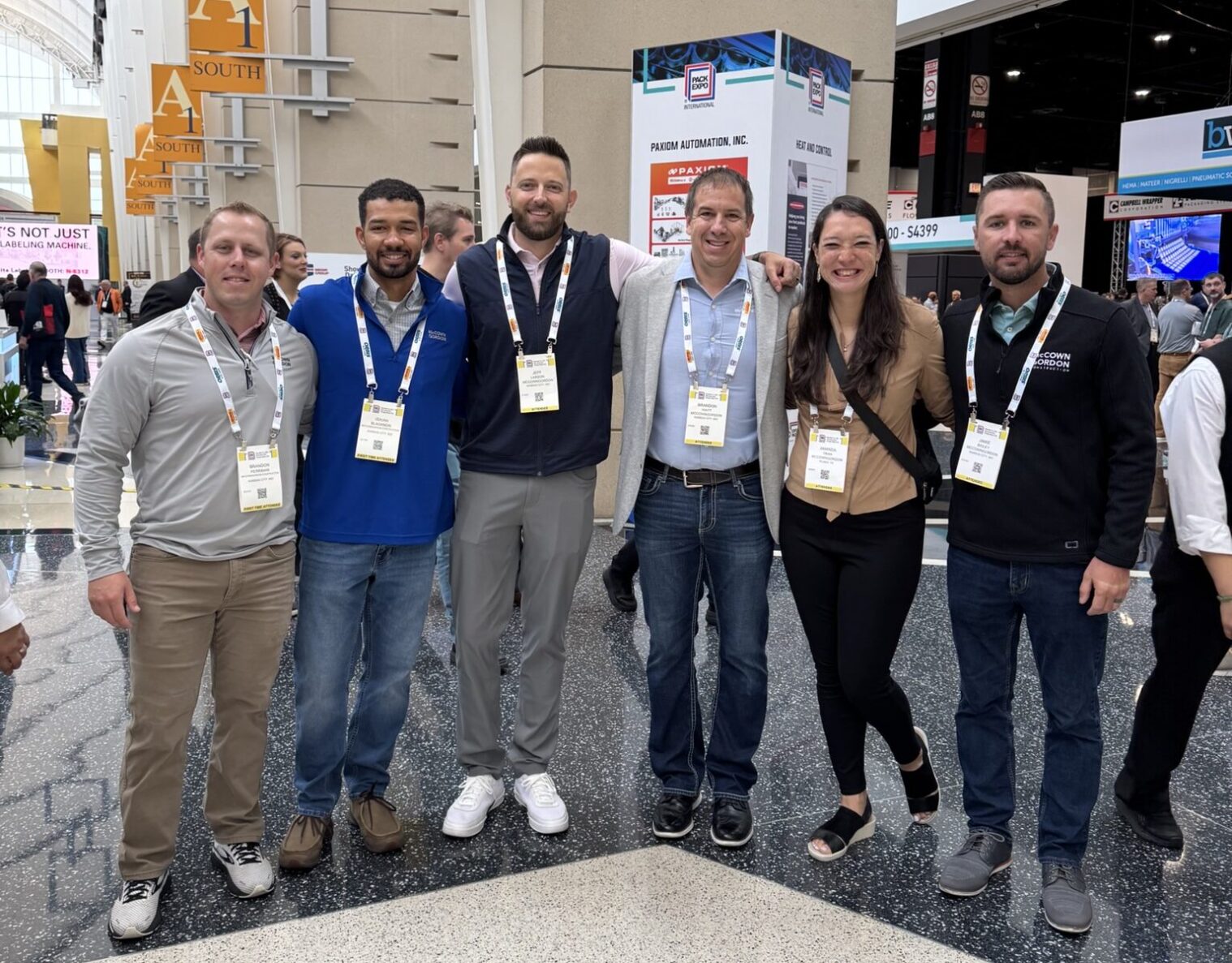Overcoming Project Challenges
At Children's Mercy Research Institute

McCownGordon recently completed the construction of Children’s Mercy Research Institute, one of just 31 exclusively pediatrics-focused research facilities in the U.S.
The nearly 400,000-square-foot, nine-story structure stands as a testament to the importance of translational medicine – research aimed at determining the relevance of pediatric diseases through novel discoveries.
Building a monumental research tower on top of an eight-story existing parking garage on an active hospital campus in a tight, urban setting with limited jobsite space, posed some challenges. But, through extensive collaboration, innovative thinking and a dogged work ethic, the team developed the creative solutions needed to deliver a state-of-the-art facility that exceeded the client’s expectations.
- Sequencing and daily activities
Our project sequencing and daily activities were coordinated with Hospital Ambulance Services, FAA and utility companies. On average, Children’s Mercy Hospital receives 6,000 ambulance and 370 helicopter arrivals per year. Hospital operations took precedence over all other work and we ensured our workers and deliveries followed suit. There were two tower cranes on the job, 240 and 270 feet in the air for 10+ hours a day and, throughout the project duration, there were eight smaller cranes. The operators constantly communicated with air traffic control to ensure all transport helicopters were clear to land and take off at any given moment. The team on the ground and in the cranes understood that being nimble and able to adjust at a moment’s notice is truly life and death.
- Traffic coordination
Because the size and scale of the research institute’s construction, the team worked diligently to minimize disruptions for daily activities. At the onset of the project all ambulance traffic was rerouted, public streets were modified and signage was added to ensure access for everyone was clear and safe. This effort required coordination, input and approval from Hospital Administration, EMS and permitting with the City of Kansas City, MO. After evaluating the benefits and drawbacks of multiple ambulance routing options, Children’s Mercy provided direction on the options that best met their needs. We worked with the city to implement lane closures. Throughout the project there were multiple daily activities that we had to coordinate with the Children’ Mercy transportation unit to ensure their operations were never disrupted.
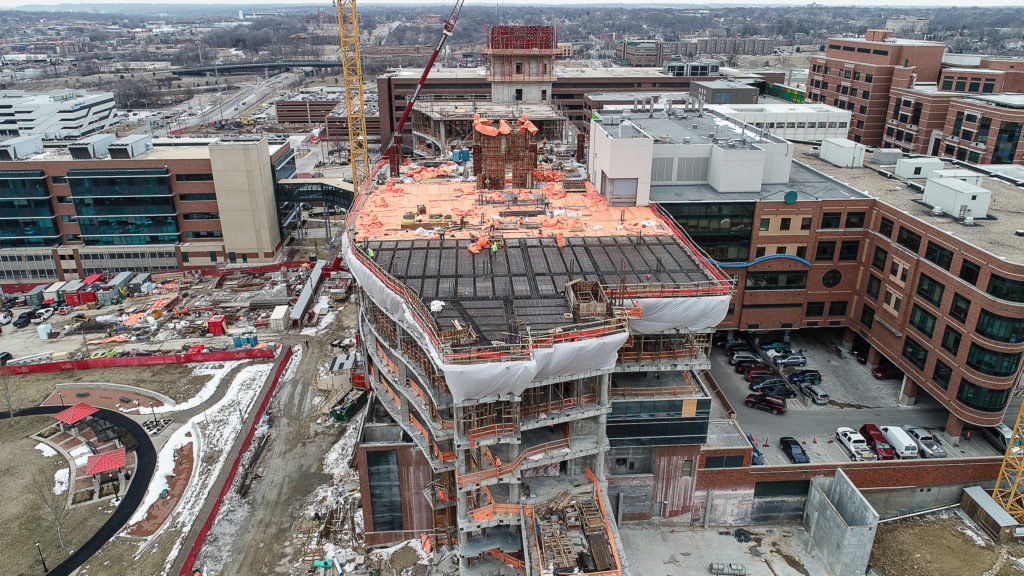
3. Utility infrastructure
A variety of major and minor utility infrastructure existed around the perimeter of the facility, which required early enabling work so new foundations could be drilled. Through a coordinated effort with the design engineers, utility managers, and our in-house Mechanical Electrical and Plumbing (MEP) staff, we identified a sequence that allowed foundations to begin two months earlier than anticipated, while protecting all existing and new utilities.
4. Safety
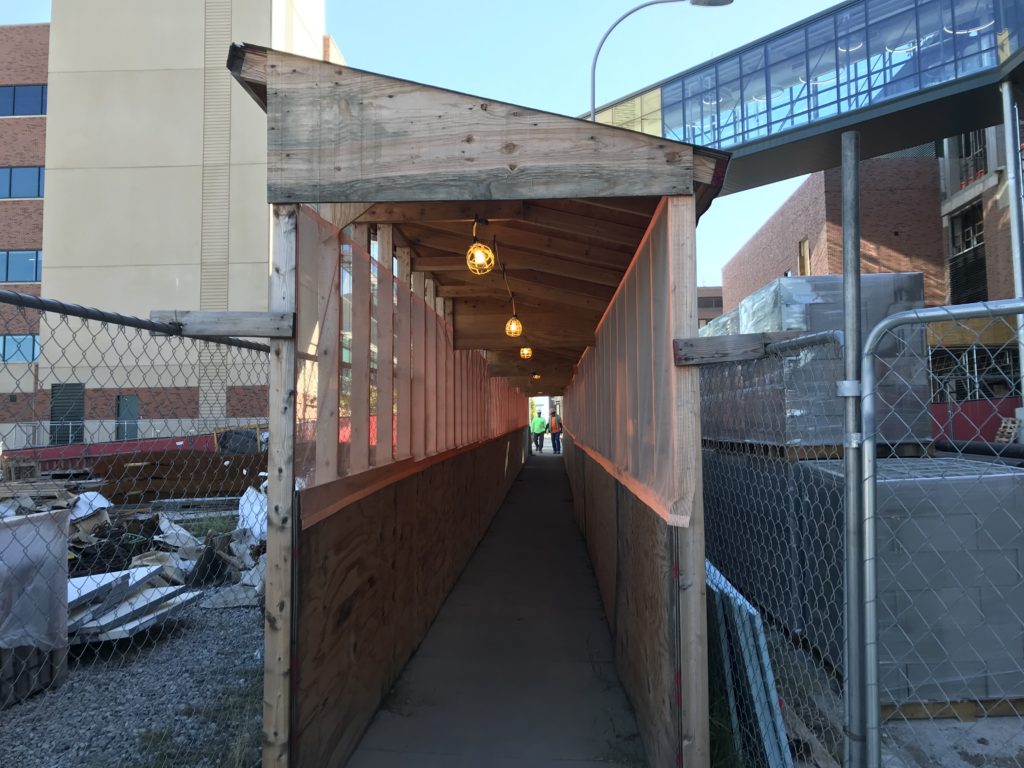
We created a covered pedestrian walkways with ample safety signage between the trailers/laydown yard and the rest of the project to keep the guest, patients and staff safe. When crossing the pedestrian walkway with equipment, spotters ensured a clear passage.
Operating two tower cranes on an active campus posed some safety concerns our team overcame by utilizing qualified riggers and signal persons, inspecting the rigging prior to every single pick, instead of just inspecting daily, utilizing spotters and maintaining contact with the tower crane operators during the picks. We empathized additional attention to detail, knowing that we had exposure and risk outside of just the construction workers.
The research institute tower sits on top of the eight-story employee parking garage at Children’s Mercy. In case of an emergencies during construction, response time can be slowed due to building on top of another structure. We overcame this by updating the fire department of our plans regularly and inviting the fire department to tour the four different times as the project progressed giving them the familiarity needed if a response was needed during the duration of the project. The team also took a proactive approach to sharing emergency plans by posting detailed emergency procedures signage on every floor of the building and discussing the procedures at regular safety meetings.
- Material specific to the project
The architect designed a unique modular curtain wall system fabricated in Canada for the envelope of the project. The pieces were and shipped in sequence, allowing the building skin to be placed two floors below concrete floor pours. The system essentially clicked into place.
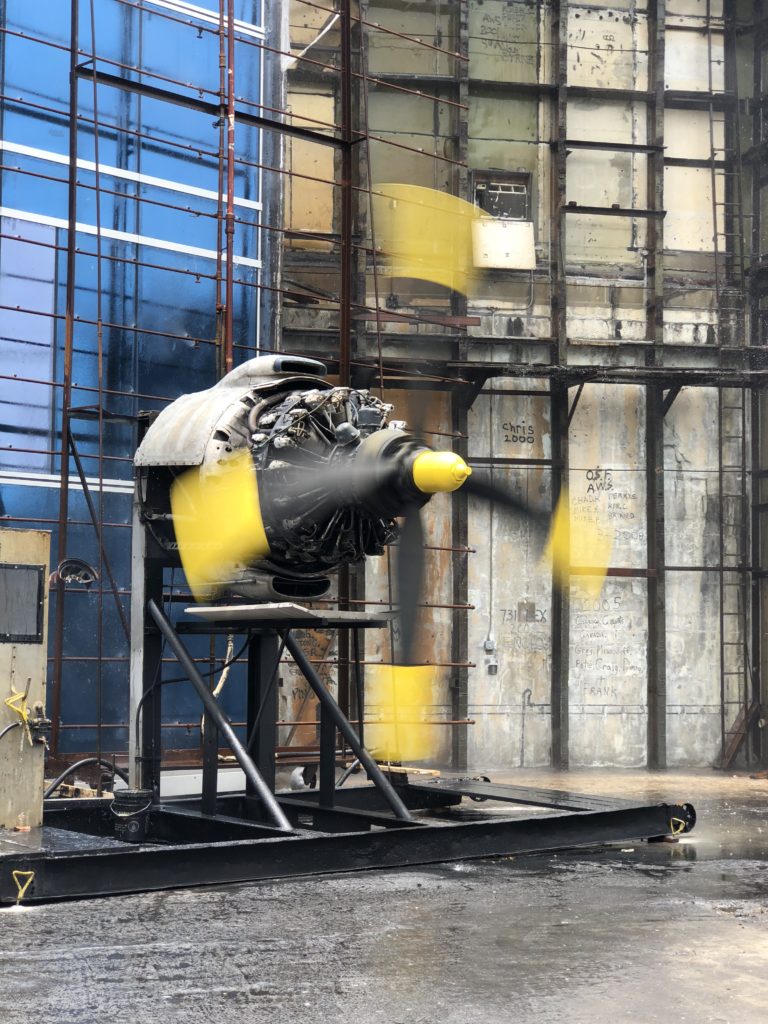
Because this curtainwall system was designed specifically for this building and never tested before, the team built a performance mockup and tested the curtain wall in a lab in Miami, one of the few testing facilities in the United States. This location is ideal because they can test round without the fear of weather affecting the testing, like it would if the lab was in Missouri during the summer or winter. The two-story mockup went through various testing, including a water wall, pressure, wind and temperature tests to sustain the elements of Missouri weather.
Water wall test – Vacuum testing with a water wall that proved the capability of preventing water intrusion to 150% of design criteria.
WATCH VIDEO OF WATER WALL TEST
Positive pressure – Test to prove the deflection criteria of the system.
Wind test – A DC10 prop engine was set up to with the water wall. The engine blew water at the wall with over 75 mph winds.
Thermal test – The building was tested through extreme conditions. First, they heated the wall to extreme high temperatures and then used liquid nitrogen to cool the wall to extreme low temperatures.
The system passed the tests and received a stamp of approval by independent third party testing laboratory.
- Height of the building
The height of the final research institute (210 ft above ground level) over an active parking garage was one of our largest challenges. The team took a belt and suspender approach, doubling up on protection measures.
Our team engineered overhead protection in multiple areas to allow the eight-story garage to stay open. As we reached level six of the tower our team added layers of plywood and 2” thick rigid foam to assist in stopping any materials that may land on top. As the structure got taller, the potential for higher velocity of any falling materials increased, so adding layers helped cushion any
impact and keep material from penetrating into the garage.
The second layer of protection was the catch net. It extended out from the building edge 10’ and was 20’ in length. The catch net provided a safety barrier to help reduce the risk of items falling all the way down to the overhead protection.
The two separate systems worked together to provide added safety to the hospital staff and visitors entering the garages.
- Elevator sequencing
The team built a total of six elevator systems, two new from the ground up and four existing elevators that needed additional floors, new rails and new cars.
To accomplish this, we first had to shut down the Energy Center’s freight elevator. Before the elevator was unoperational, the team first built a concrete shaft around the current elevator shaft and extended it up to 10 additional stories. During this process, the team added a temporary roof to keep the elevator running. We then removed the original elevator shaft; shutting down the only elevator that accessed the energy center. Once the demolition took place, the team then added a new elevator car, railings and doors on each floor. Coordinating the down time to ensure each floor had all their supplies and chemicals needed for research until the elevator became operational again was crucial.
Another elevator challenge our team overcame was adding renovating and adding on to three elevator shafts. The challenge keeping two elevators running at time. On site there were three elevator shafts (two in operation at the time) that needed to have additional floors and updated rails and cars. Since the operating elevators were used for staff, Children’s Mercy wanted to always keep two running to minimize disruptions to their staff. The team first worked on the empty shaft, building up three stories and completing the interior finishes. The team then added the additional floors and new elevator cars and railings to the two existing shafts, one at a time.
- Laboratory sequencing
This building includes many different labs, requiring extensive coordination. As the team worked their way up the building, we adapted new cleaning levels depending on the labs.
The BMP (Best Management Practices) space was the first super clean lab space. The BSL3 (Bio safety level 3), another super clean space, followed. Each lab required its own set of clean room protocols. To ensure each room was cleaned properly, the team made a process in our project management software, Procore, to communicate the standards to everyone working in those rooms.
The team performed in-wall clean ups to ensure the clean and sterile nature of the room; vacuuming out the inside of walls and wiping down and disinfecting each surface before sealing them. Regularly, we inspected with the design and Children’s Mercy team to ensure every slab penetration was fire calked as well as spotless within the wall so life changing research would not be compromised. After these spaces were enclosed, each lab required different cleaning protocols to ensure whatever went into the space was either installed or came out prior to the daily cleaning.
- COVID-19 protocols
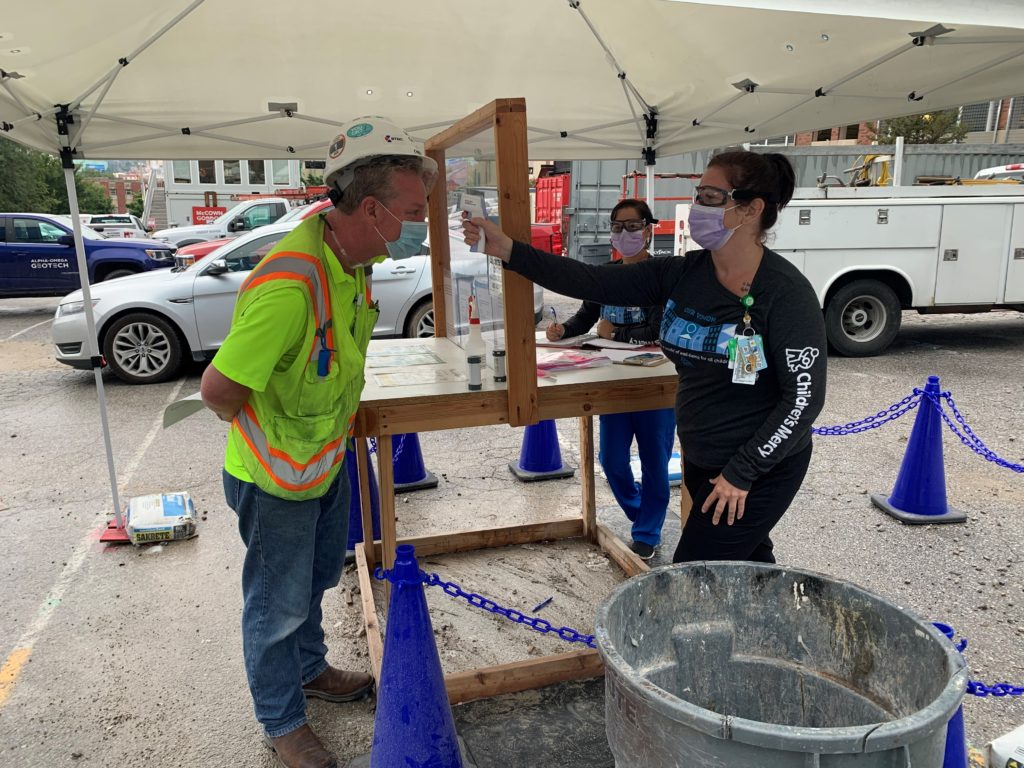
This project was well underway when the pandemic hit Kansas City. The team brought nurses on site to conduct health screenings of every worker before entering the building. Along with our labor foremen who cleaned the site daily, a specialized cleaning crew to continuously clean and disinfect high traffic/high-touched areas to prevent the spread of the virus
Our superintendent was proactive as soon as he learned about COVID-19, he secured additional sanitation stations on the jobsite before they were in high demand. The team also limited the number of individuals on the elevator and changed all in-person meetings to virtual.
Even though the team faced many challenges from utility infrastructure to hospital coordination to COVID-19 procedures and more, we found a way to meet the hospital’s expectations through constant and clear communication. We built a strong relationship with the hospital supervisors so tough conversations became easier.
This collaboration resulted in a seamless project that opened on time and on budget.
Hear what Paul Kepenski, CEO of Children’s Mercy had to say about the new Research Institute.





